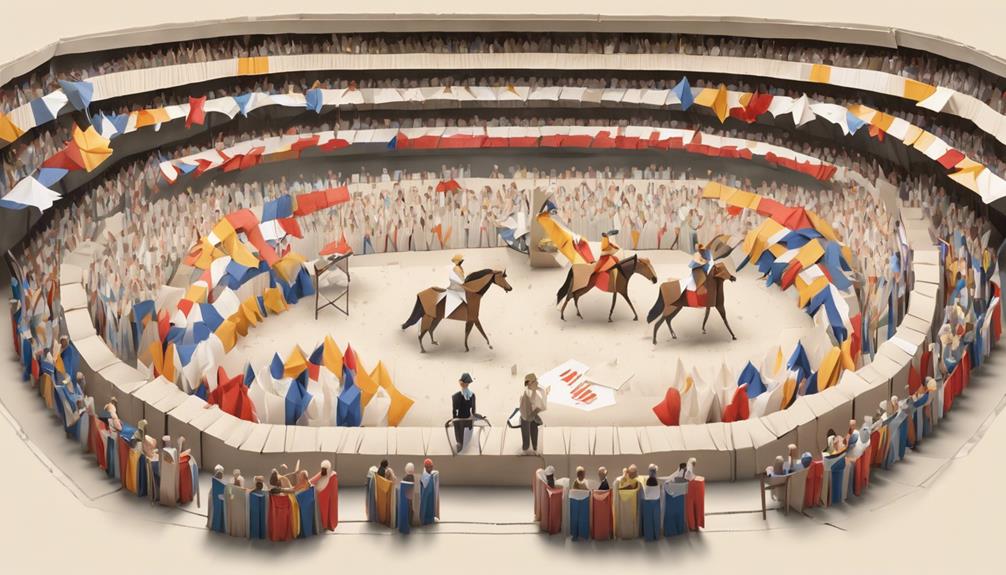General Rules of Equestrian Vaulting
As you enter the world of equestrian vaulting, understanding the general rules and guidelines is vital. You'll need to prioritize horse welfare and safety, ensuring proper stable management and recognizing early signs of fatigue or stress. You'll also need to adhere to equipment and attire requirements, such as wearing a well-fitting helmet and comfortable, flexible clothing. Mastering compulsory exercises and routines is vital, and understanding judging criteria and scoring will help you optimize your performance. Familiarize yourself with competition formats and rules to capitalize on scoring opportunities. As you explore these rules, you'll uncover the intricacies that separate a good vaulter from a great one.
Horse Welfare and Safety

As you engage in equestrian vaulting, prioritizing the horse's welfare and safety is essential, since horses are more likely to suffer injuries or develop behavioral problems if they're subjected to poor training or handling practices. You must prioritize their well-being, as it's fundamental for a successful and enjoyable experience for both you and the horse.
Proper stable management is imperative in maintaining the horse's physical and mental health. This includes providing a clean and comfortable living environment, guaranteeing access to fresh water and nutritious food, and implementing a regular exercise and training schedule. Rider awareness is also critical, as it enables you to recognize early signs of fatigue, stress, or discomfort in the horse. By being attentive to the horse's behavior and body language, you can adjust your training techniques and safeguard a safe and enjoyable experience for both parties. Remember, a happy and healthy horse is essential for a successful equestrian vaulting experience.
Equipment and Attire Requirements
You'll need to invest in specialized equipment and attire that meets specific safety and functional standards to guarantee a successful and safe equestrian vaulting experience. As a vaulter, you'll require a well-fitting helmet that conforms to international safety standards, protecting you from head injuries. Your attire should comprise of comfortable, flexible clothing that allows for a full range of motion, such as stretchy pants and a breathable top. Proper fittings are vital, so make certain your attire is tailored to fit you snugly, avoiding loose fabric that could get caught in the horse's equipment.
Choose safe materials that can withstand the rigors of vaulting, such as durable, non-slip fabrics and sturdy footwear with a low heel. Your gloves should provide grip without compromising dexterity, allowing you to maintain control and balance on the horse. Remember to select equipment that is designed specifically for equestrian vaulting, as it's engineered to meet the unique demands of this discipline. By investing in the right gear, you'll be free to focus on perfecting your technique, unencumbered by concerns about your safety.
Compulsory Exercises and Routines

In equestrian vaulting competitions, riders must master a set of compulsory exercises and routines that test their strength, flexibility, and coordination while astride a moving horse. These exercises are designed to assess your ability to maintain balance, control, and poise while performing intricate movements on the horse's back. As you practice these exercises, you'll develop muscle memory, allowing your body to instinctively respond to the horse's movements, freeing you to focus on the creative expression of your routine.
The compulsory exercises include mounts, passages, and dismounts, as well as various poses, lifts, and movements that demonstrate your balance, strength, and agility. Mastering these exercises is essential to achieving creative freedom in your freestyle routines. By perfecting the compulsory exercises, you'll gain the confidence and skill to express yourself freely and creatively, pushing the boundaries of what's possible in equestrian vaulting. Remember, the key to success lies in precision, control, and practice – with dedication and perseverance, you'll release your full potential and experience the liberation that comes with mastering this unique and thrilling sport.
Judging Criteria and Scoring
Your performance in equestrian vaulting competitions is evaluated based on a precise set of judging criteria, which assesses your technical execution, artistic expression, and overall presentation. This thorough evaluation guarantees that you're judged on multiple aspects of your performance, providing a well-rounded assessment of your skills.
- Technical Difficulty: The complexity and risk of your movements, including the height, distance, and direction of your vaults.
- Execution: The precision, control, and fluidity of your movements, including your balance, strength, and coordination.
- Artistic Impression: The creativity, originality, and aesthetic appeal of your performance, including your style, flair, and showmanship.
- Overall Presentation: Your confidence, poise, and charisma, including your interaction with the horse, the audience, and the music.
Competition Format and Rules

As you prepare to compete, understanding the competition format and rules that govern equestrian vaulting events is crucial, making certain you're well-versed in the specifics of competition structure and protocol. In equestrian vaulting competitions, teams typically consist of 6-8 vaulters, and events are divided into compulsory and freestyle exercises. The compulsory exercises focus on individual skills, while the freestyle exercises showcase team creativity and synchronization.
You'll need to develop effective team strategies to maximize your scores, as judges evaluate your performances based on factors like execution, balance, and overall impression. To facilitate accurate scoring, competitions employ advanced Scorekeeping Systems that track and calculate scores in real-time. These systems enable judges to provide detailed feedback, helping you refine your skills and improve your overall performance.
Familiarize yourself with the competition rules and format to optimize your performance and make the most of your equestrian vaulting experience. By grasping the intricacies of competition structure and protocol, you'll be better equipped to develop winning team strategies and capitalize on scoring opportunities.
Frequently Asked Questions
Can Vaulters Compete Individually or Only in Teams?
You're wondering if you can shine solo or need a squad to vault? Well, you can do both! Solo performances showcase individual skill, while team dynamics amplify energy and creativity, so choose your ride wisely!
What Age Do Vaulters Typically Start Competing?
You'll find that vaulting prodigies often start training as early as 5 or 6 years old, with some beginning their competitive journey around 10-12 years old, marking an early start to a promising career in this equestrian discipline.
How Long Are Equestrian Vaulting Competitions Typically?
You're about to discover the thrill of equestrian vaulting competitions, where athletes perform aerial stunts on horseback. Typically, competitions last around 6-8 minutes, with event scheduling allowing for multiple rounds and a final freestyle round.
Can Vaulters Wear Any Type of Footwear?
When you're vaulting, you'll need shoes that prioritize sole protection and ankle support; fortunately, you can wear specialized footwear designed for equestrian activities, which provide the necessary stability and protection for your feet.
Are There Equestrian Vaulting Leagues for Beginners?
You'll find equestrian vaulting leagues for beginners through vaulting clinics and Novice programs, designed to introduce you to this liberating sport, focusing on building your skills and confidence in a supportive environment.






